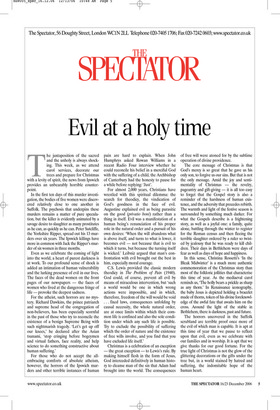Evil at a holy time
The juxtaposition of the sacred and the unholy is always shocking. This week, as we attend carol services, decorate our trees and prepare for Christmas with a levity of spirit, the news from Ipswich provides an unbearably horrible counterpoint.
In the first ten days of this murder investigation, the bodies of five women were discovered relatively close to one another in Suffolk. The psychosis that underpins these murders remains a matter of pure speculation, but the killer is evidently animated by a savage desire to slaughter as many prostitutes as he can, as quickly as he can. Peter Sutcliffe, the Yorkshire Ripper, spread out his 13 murders over six years. The Ipswich killings have more in common with Jack the Ripper’s murder of six women in three months.
Even as we celebrate the coming of light into the world, a heart of purest darkness is at work. To our profound sense of shock is added an intimation of human vulnerability and the lurking presence of evil in our lives. The faces of the dead women on the front pages of our newspapers — the faces of women who lived at the dangerous fringe of life — provoke the deepest sadness.
For the atheist, such horrors are no mystery. Richard Dawkins, the prince patriarch and supreme head of the congregation of non-believers, has been especially scornful in the past of those who try to reconcile the existence of a benign Supreme Being with such nightmarish tragedy. ‘Let’s get up off our knees,’ he declared after the Asian tsunami, ‘stop cringing before bogeymen and virtual fathers, face reality, and help science to do something constructive about human suffering.’ For those who do not accept the allembracing comforts of absolute atheism, however, the horrors of the Ipswich murders and other terrible instances of human pain are hard to explain. When John Humphrys asked Rowan Williams in a recent Radio Four interview whether he could reconcile his belief in a merciful God with the suffering of a child, the Archbishop of Canterbury had the honesty to pause for a while before replying: ‘Just’.
For almost 2,000 years, Christians have wrestled with this spiritual dilemma: the search for theodicy, the vindication of God’s goodness in the face of evil. Augustine explained evil as being parasitic on the good (privatio boni) rather than a thing in itself. Evil was a manifestation of a human being’s renunciation of his proper role in the natural order and a pursuit of his own desires: ‘When the will abandons what is above itself, and turns to what is lower, it becomes evil — not because that is evil to which it turns, but because the turning itself is wicked.’ Leibniz argued that man’s confrontation with evil brought out the best in him, especially moral courage.
C.S. Lewis provided the classic modern theodicy in The Problem of Pain (1940). God could, of course, prevent all evil by means of miraculous intervention, but ‘such a world would be one in which wrong actions were impossible, and in which, therefore, freedom of the will would be void ... fixed laws, consequences unfolding by causal necessity, the whole natural order, are at once limits within which their common life is confined and also the sole condition under which any such life is possible. Try to exclude the possibility of suffering which the order of nature and the existence of free wills involve, and you find that you have excluded life itself.’ Christmas is a celebration of an exception — the great exception — to Lewis’s rule. By making himself flesh in the form of Jesus, God interceded definitively in human history to cleanse man of the sin that Adam had brought into the world. The consequences of free will were atoned for by the sublime operation of divine providence.
The core message of Christmas is that God’s mercy is so great that he gave us his only son, to forgive us our sins. But that is not the only message. Amid the joy and sentimentality of Christmas — the revelry, pageantry and gift-giving — it is all too easy to forget that the Gospel story is also a reminder of the harshness of human existence, and the adversity that precedes rebirth. The warmth and light of the festive season is surrounded by something much darker. For what the Gospels describe is a frightening story, as well as a joyful one: a family, quite alone, battling through the winter to register for the Roman census and then fleeing the terrible slaughter ordered by a ruler so twisted by jealousy that he was ready to kill children. Their days in Bethlehem were days of fear as well as days of hope and happiness.
In this sense, Christina Rossetti’s ‘In the Bleak Midwinter’ is a much more authentic commemoration of the Christmas story than most of the folkloric jollities that characterise this time of year. As the mediaeval carol reminds us, ‘The holly bears a prickle as sharp as any thorn.’ In Renaissance iconography, the baby Jesus is depicted holding a bracelet made of thorns, token of his divine foreknowledge of the awful fate that awaits him on the cross. Around the light of the stable in Bethlehem, there is darkness, past and future.
The horrors uncovered in the Suffolk scrubland are terrible proof once more of the evil of which man is capable. It is apt at this time of year that we pause to reflect upon that evil, even as we celebrate with our families and in worship. It is apt that we give thanks for our good fortune. For the true light of Christmas is not the glow of the glittering decorations or the gifts under the tree but, in a world stained by hatred and suffering, the indomitable hope of the human heart.






































































































































 Previous page
Previous page